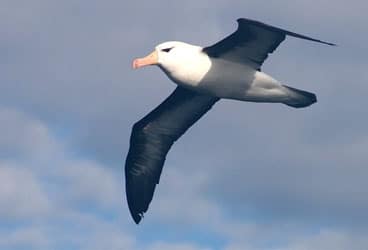
HWalbatross 368
Six hours after we set out from Mar del Plata, Argentina, bound for the Falkland Islands-or, as Argentina calls them, the Islas Malvinas-the big, cigar-shaped front rolled in from the west. We’d certainly been expecting it; the forecast was spot on. Minutes later, we’d tucked the third reef into the main aboard our 64-foot cutter, Ocean Watch. We were 20 miles shy of 40 degrees south, the entrance to the notorious Roaring 40s, and to make sure we understood the significance, the weather gods had arranged for a nice, welcoming gale.
By midnight, it was blowing a solid 35 knots, with gusts in the low 40s, topping off at a sporty 47 knots. It turned into a long evening. On our ongoing quest to sail Around the Americas (www.aroundtheamericas.org), it was the most breeze we’d seen in quite some time. In fact, the last time we’d changed down from the working staysail to the tiny storm staysail in such brisk winds, we’d been off Baffin Island, in the Labrador Sea. But we certainly weren’t surprised. After all, by the break of the stormy dawn, we were firmly ensconced in those Roaring 40s.
The 600 nautical-mile swath of latitude between 40 degrees south and 50 degrees south earned its catchy nickname for the perpetual low-pressure systems that spin along that corridor on relentless jaunts around the planet. When sailors point their bow south into the high latitudes of the Southern Hemisphere, the issue isn’t if they’re going to get hammered, but when. So we couldn’t say that the nasty cold front and Force 8 conditions were at all a surprise.
No, the surprise came once the front had passed.
For in its aftermath, the skies cleared, the wind backed into the north, and the wicked seas subsided. We shook out a reef, poled out the genoa, and under a wing-and-wing configuration, Ocean Watch started gobbling up the miles southward.
On top of that, the albatross began to appear. We’d started seeing them earlier, around 30 south, but only on occasion. Now they were almost constant companions. At first, our visitors were of the black-browed and yellow-nosed variety, but after a short while, they were joined by the mighty wandering albatross, the most majestic of all seabirds, with wingspans up to 10 feet. We watched them endlessly, gliding over the wavelets, never tiring of the spectacle.
The birds, not the weather, came to symbolize our southbound voyage toward the Falklands. After the first rough night at sea, we never faced another moment of heavy weather until our final approach to the islands, and even that 30-knot squall was brief. On our last morning of the trip, scores and scores of albatross soared around the boat. They were with us as we crossed the 50th parallel and made our way to Stanley. And that’s what we’ll remember: the gale and the albatross that were the bookends to our lucky dash through the Roaring 40s.








